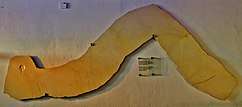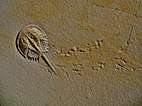Mortichnia
A mortichnia is the "death march", or last walk, of a living creature.[1] These are sometimes preserved as fossil footprints.
Notable examples
In 2002 the mortichnia of a horseshoe crab was found in lithographic limestone in Bavaria, Germany.[2][1] The trail measured 9.7m and was left about 150 million years ago when the crab died in an anoxic lagoon.[1] The footprints left enough evidence for researchers to determine that the creature probably fell into the lagoon upside-down, righted itself, and started walking before succumbing to the anoxic conditions of the water.[1] The trackway is currently exhibited at the Wyoming Dinosaur Center.[3]
gollark: This would not actually do anything.
gollark: Well, it uses R/G/B color channels, so you would need an alternate color space.
gollark: As planned.
gollark: Python/Pillow (PIL fork).
gollark: Unfortunately, this is limited by available display technologies.
See also
- Kouphichnium, an ichnogenus attributed to horseshoe crabs
References
- "Fossil records 'crab' death march". BBC. Retrieved September 7, 2012.
- Lomax, Dean R.; Racay, Christopher A. (2012). "A Long Mortichnial Trackway of Mesolimulus walchi from the Upper Jurassic Solnhofen Lithographic Limestone near Wintershof, Germany". Ichnos: An International Journal for Plant and Animal Traces. 19 (3): 175–183. doi:10.1080/10420940.2012.702704.
- "Final Journey of the Horseshoe Crab: The Longest Mortichnial Trackway in the Fossil Record". Retrieved 2020-05-25.
This article is issued from Wikipedia. The text is licensed under Creative Commons - Attribution - Sharealike. Additional terms may apply for the media files.

